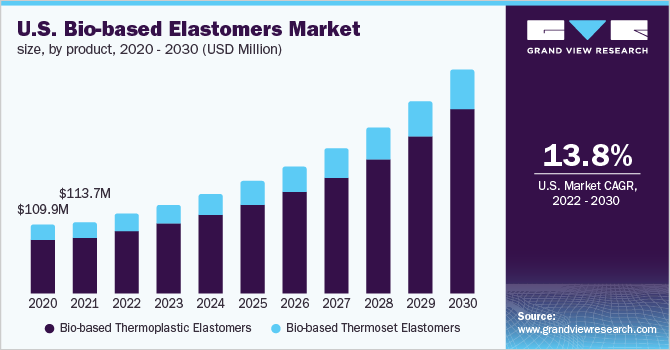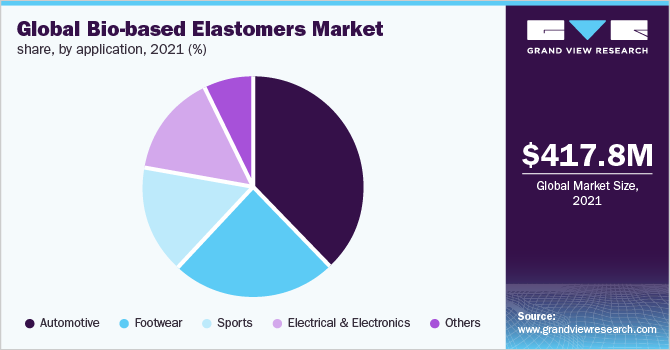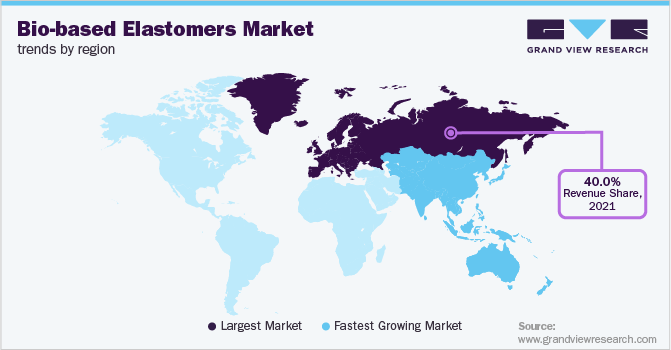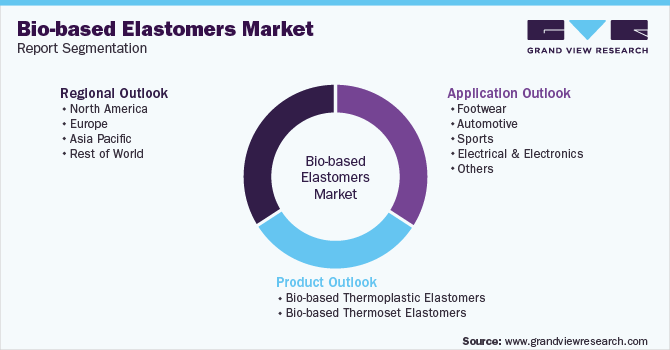- Home
- »
- Plastics, Polymers & Resins
- »
-
Bio-based Elastomers Market Size & Share Report, 2030GVR Report cover
![Bio-based Elastomers Market Size, Share & Trends Report]()
Bio-based Elastomers Market (2022 - 2030) Size, Share & Trends Analysis Report By Product (Bio-based Thermoplastic, Bio-based Thermoset), By Application (Automotive, Footwear, Sports, Electrical & Electronics), By Region, And Segment Forecasts
- Report ID: GVR-4-68040-006-6
- Number of Report Pages: 120
- Format: PDF
- Historical Range: 2019 - 2020
- Forecast Period: 2022 - 2030
- Industry: Bulk Chemicals
- Report Summary
- Table of Contents
- Segmentation
- Methodology
- Download FREE Sample
-
Download Sample Report
Report Overview
The global bio-based elastomers market size was valued at USD 417.82 million in 2021 and is expected to expand at a compound annual growth rate (CAGR) of 13.9% from 2022 to 2030. The growing demand for utilizing bio-based materials to reduce the carbon footprint is driving conventional elastomer manufacturers to develop partial blends or fully bio-based elastomers. Thermoset and thermoplastic crude oil-based elastomers largely depend on petrochemicals. The volatility in crude oil prices due to geopolitical factors has significantly contributed to developments being carried out in the market.

For instance, Green Dot Plastics, based in Kansas, U.S. has been involved in the development of Terratek Flex GDH-B1, a starch-based bio-based elastomer formulated with 35% of bio-based content since 2011. Although the development of bio-based elastomers presents lucrative growth opportunities, their high prices portray a significant challenge to their market growth, which can be anticipated to reduce during the upcoming years.
The U.S. is expected to witness significant growth in the demand for bio-based elastomers. This is due to the fact the country hosts a number of conventional elastomer manufacturers such as Avient Corporation, Huntsman International LLC, The Lubrizol Corporation, Trinseo, and Dow that are now engaged in the development of bio-based elastomers. For instance, Dow manufactures bio-based polyolefin elastomers under the brand name AFFINITY RE. In addition, the National Biotechnology and Biomanufacturing Initiative launched by the U.S. Government in September 2022 to embrace bio-manufacturing to produce bio-based fuels, bio-based plastics, bio-based medicines, and other bio-based materials is expected to further contribute to the high growth of bio-based elastomers in the U.S.
Technology collaboration is being observed among elastomer raw material manufacturers to develop bio-based alternatives. Such instances create a sufficient supply of bio-based raw materials, enabling adequate production of bio-based elastomers. For instance, in May 2021, U.S.-based Lummus Technology entered into a cooperation agreement with Synthos to commercialize the bio-butadiene technology of Synthos for the development of bio-based butadiene, thus creating an adequate monomer supply for bio-based elastomer production.
Product Insights
The bio-based thermoplastic elastomers accounted for the largest revenue share of more than 75.0% in 2021. This is attributed to the growing adoption in automotive applications as an alternative to conventional crude oil-based elastomers with the equivalent shore hardness from 55 shore A to 80 shore A. Some of the bio-based thermoplastic elastomers developed in the market include bio-based thermoplastic polyolefin elastomers, bio-based thermoplastic polyurethane elastomers, bio-based thermoplastic styrene block copolymer elastomers, and bio-based thermoplastic polyamide elastomers.
Bio-based thermoset elastomers include bio-based ethylene propylene diene monomers and bio-based silicone elastomers. ARLANXEO has been producing Keltan Eco EPDM commercially since 2013. The company sources bioethylene from Braskem. The bio-based EPDM offers similar oxidative and thermal resistance properties as that of conventional EPDM, which can help it project a feasible alternative to replace conventional EPDM in the coming years. The eco-grade silicone elastomers manufactured by Wacker Chemie under the ELASTOSIL brand offer exceptional tear resistance and are used for producing binders for the textile, paper, and consumer goods industries.
Application Insights
Automotive emerged as the leading application segment and accounted for more than 35.0% share in terms of revenue in 2021. Decreasing the vehicle weight to improve fuel consumption and reducing CO2 emission are significant objectives for the automotive industry. Thermoplastic elastomers are useful in automotive interior applications such as inlay mats, fascia, cup holder liners, and exterior windshield wipers. Materials used in automotive interiors need to meet requirements for Vehicle Interior Air Quality (VIAQ) and legislation regarding odor, fogging, and VOC. The bio-based elastomers contain a significant amount of bio-based content and exhibit a low amount of VOC, which is positively driving its consumption in the automotive industry.

Footwear emerged as the next leading application segment in 2021. The production of footwear has significant negative environmental impacts on the environment due to the use of leather, polyurethane, polyvinyl chloride, and rubber, which end up in landfills. Recently, various large sports goods brands have announced the introduction of fully biodegradable high-performance athletic footwear, which can positively influence the demand for bio-based elastomers. For instance, Nike used 50% Pebax Renew, a castor-based thermoplastic elastomer, manufactured by Arkema that contains about 97% renewable-based components along with 50% bio-based thermoplastic polyurethanes (TPU) in its GS football boot.
Regional Insights
Europe accounted for the largest revenue share of more than 40.0% in 2021. Bio-Based Industries Joint Undertaking (BBI JU) was launched in 2014 between the Bio-based Industries Consortium and European Union to accelerate the consumption of bio-based content in various end-use industries.
In addition, the European Chemicals Agency (ECHA) submitted a proposal to ban rubber granules produced from end-of-life vehicle tires, which has driven tire manufacturers in Europe to consider bio-based raw materials for tire production, thus presenting a positive growth opportunity for bio-based elastomers. In line with the current developments aimed at increasing the bio-based material content in the products, France-based tire manufacturer Michelin unveiled a plan in June 2018 to ensure 80% sustainable materials consumption in its tires by 2048.

North America is expected to witness a growing demand for bio-based elastomers due to the presence of a significant number of bio-based elastomer manufacturers in the region. Similarly, the growing demand for electric vehicles in North America due to supportive government policies is expected to increase the demand for electric vehicle charging cables in the region, which can positively influence the consumption of bio-based elastomers in cable jackets.
China is characterized by massive consumption of elastomers from the footwear industry. This has resulted in extensive research and development activities being carried out in the footwear market to develop sustainable materials. In August 2022, the Beijing University of Chemical Technology developed bio-based polyester elastomer soles for bio-degradable footwear manufactured using corn stalk latex, bamboo fiber, and hemp fiber.
Key Companies & Market Share Insights
The market is fragmented and highly competitive with the presence of a number of multinational companies across the major economies. However, the market is still in the development stage with a limited scope of application, which presents high growth potential over the forecast period. The companies operating in the market are conventional crude oil-based elastomer manufacturers, which lay a high emphasis on increasing the penetration of bio-based elastomers in the market.
Bio-based elastomer companies are creating new product variants to gain a competitive advantage and strengthen their market position. For instance, in February 2021, DSM collaborated with Sympatex Technologies to launch a bio-based thermoplastic elastomer under the brand name Arnitel. Some prominent players in the global bio-based elastomers market include:
-
Dow
-
FKuR
-
BASF SE
-
ARLANXEO
-
Trinseo
-
Eni S.p.A.
-
Asahi Kasei Corporation
-
DSM
-
Mitsubishi Chemical Europe GmbH
-
Arkema
-
The Goodyear Tire & Rubber Company
-
The Lubrizol Corporation
-
KURARAY CO., LTD.
-
Wacker Chemie AG
-
Huntsman International LLC
-
Covestro AG
-
HEXPOL TPE
-
Avient Corporation
Bio-based Elastomers Market Report Scope
Report Attribute
Details
Market size value in 2022
USD 463.49 million
Revenue forecast in 2030
USD 1.3 billion
Growth rate
CAGR of 13.9% from 2022 to 2030
Base year for estimation
2021
Historical data
2019 - 2020
Forecast period
2022 - 2030
Quantitative units
Volume in tons, revenue in USD million, and CAGR (%) from 2022 to 2030
Report coverage
Volume forecast, revenue forecast, company profiles, competitive landscape, growth factors, and trends
Segments covered
Product, application, region
Region scope
North America; Europe; Asia Pacific; Rest of the World
Country scope
U.S.; Canada; Germany; Netherlands; France; U.K.; Italy; China; India; Japan
Key companies profiled
Dow; FKuR; BASF SE; ARLANXEO; Trinseo; Eni S.p.A.; Asahi Kasei Corporation; DSM; Mitsubishi Chemical Europe GmbH, Ltd.; Arkema; The Goodyear Tire & Rubber Company; The Lubrizol Corporation; KURARAY CO., LTD.; Wacker Chemie AG; Huntsman International LLC; Covestro AG; HEXPOL TPE; Avient Corporation
Customization scope
Free report customization (equivalent up to 8 analyst’s working days) with purchase. Addition or alteration to country, regional, and segment scope.
Pricing and purchase options
Avail customized purchase options to meet your exact research needs. Explore purchase options
Global Bio-based Elastomers Market Segmentation
This report forecasts revenue and volume growth at the global, regional, and country levels and provides an analysis of the latest industry trends and opportunities in each of the sub-segments from 2019 to 2030. For this study, Grand View Research has segmented the global bio-based elastomers market report based on product, application, and region:

-
Product Outlook (Volume, Tons; Revenue, USD Million, 2019 - 2030)
-
Bio-based Thermoplastic Elastomers
-
Bio-based Thermoset Elastomers
-
-
Application Outlook (Volume, Tons; Revenue, USD Million, 2019 - 2030)
-
Footwear
-
Automotive
-
Sports
-
Electrical & Electronics
-
Others
-
-
Regional Outlook (Volume, Tons; Revenue, USD Million, 2019 - 2030)
-
North America
-
U.S.
-
Canada
-
-
Europe
-
Germany
-
Netherlands
-
U.K.
-
France
-
Italy
-
-
Asia Pacific
-
China
-
India
-
Japan
-
-
Rest of World
-
Frequently Asked Questions About This Report
b. The global bio-based elastomers market size was estimated at USD 417.82 million in 2021 and is expected to reach USD 463.49 million in 2022.
b. The global bio-based elastomers market is expected to grow at a compound annual growth rate of 13.9% from 2022 to 2030 to reach USD 1.3 billion by 2030.
b. The bio-based thermoplastic elastomers accounted for the largest share of the product segment and accounted for over 76.0% revenue share in 2021. This is attributed to its growing adoption in automotive applications as an alternative to conventional crude oil based elastomers with the equivalent shore hardness from 55 shore A to shore 80 share shore A.
b. Some of the key players in the bio-based elastomers market include Dow, FKuR, BASF SE, ARLANXEO, Trinseo, Eni S.p.A., Asahi Kasei Corporation, DSM, Mitsubishi Chemical Europe GmbH, Ltd., Arkema, The Goodyear Tire & Rubber Company, and The Lubrizol Corporation.
b. The key factor driving the bio-based elastomers market include adoption of bio-based materials in automotive industry.
Share this report with your colleague or friend.
Need a Tailored Report?
Customize this report to your needs — add regions, segments, or data points, with 20% free customization.

ISO 9001:2015 & 27001:2022 Certified
We are GDPR and CCPA compliant! Your transaction & personal information is safe and secure. For more details, please read our privacy policy.
Trusted market insights - try a free sample
See how our reports are structured and why industry leaders rely on Grand View Research. Get a free sample or ask us to tailor this report to your needs.










